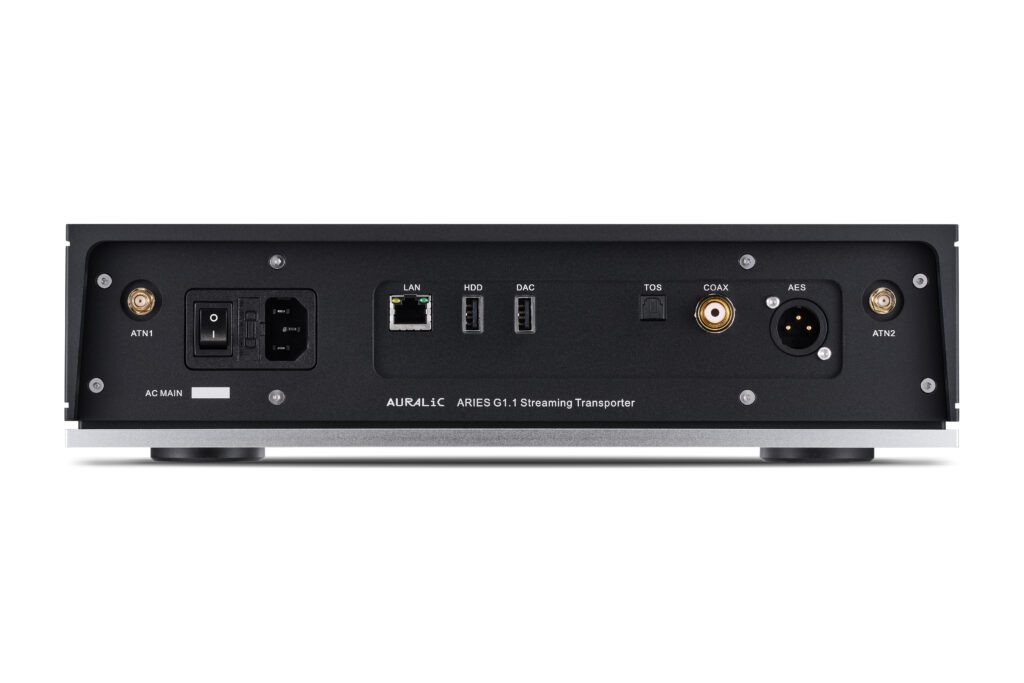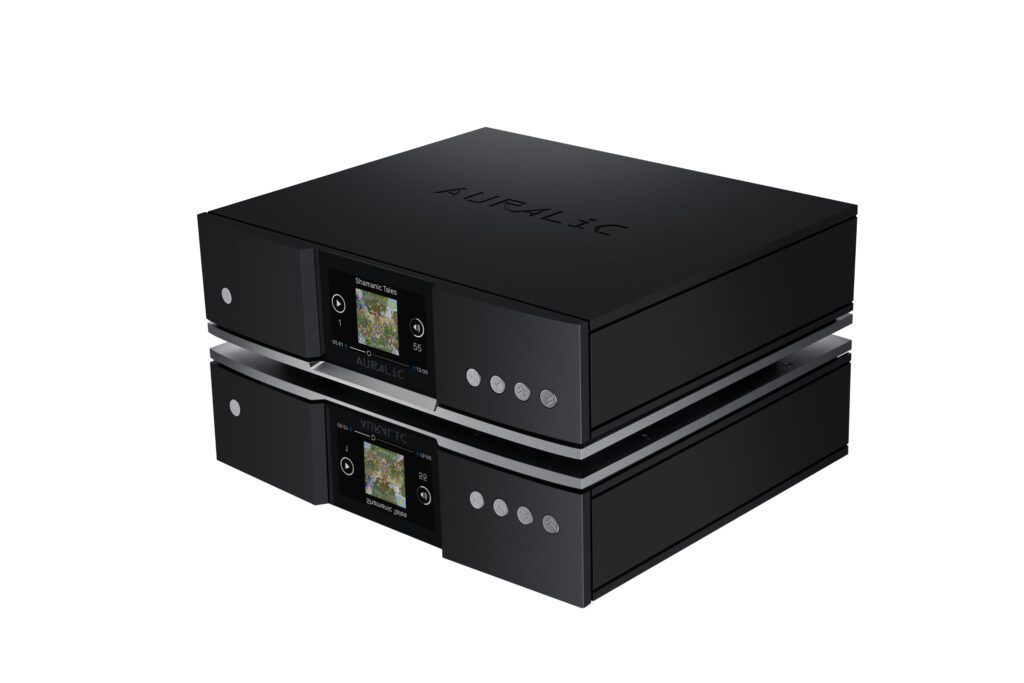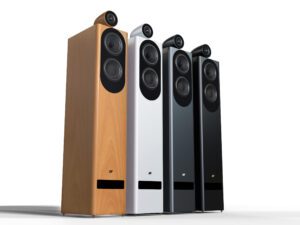
We have a peculiar habit in the world of hi-fi, something that runs against the zeitgeist found elsewhere in household appliances. We always want to break systems down into component parts. This is generally a good idea where ultimate sound quality is the goal but does push the pursuit into a corner when it comes to domestic acceptability. Only in the kitchen will you find so many different devices and even there they are usually complete units, I don’t think you can get a two-box toaster, but if you can I’m interested!
AURALiC is rather more guilty of this than average; its top-flight G2.1 streaming system consists of up to four chunky cases with separate streamer, DAC, upsampler and word clock, and this is just a source. You don’t need to go this far of course, AURALiC also makes a single box solution in the ALTAIR G2.1 and a more affordable version thereof called ALTAIR G1.1, but where’s the fun in a device that you can’t upgrade with extra boxes? Naim proved years ago that incremental box additions appeal to the upgraders and AURALiC has clearly taken their lead.
In the world of AURALiC, the ARIES is a ‘Wireless Streaming Transporter’, with no DAC onboard. The company’s first creation was an ARIES, it didn’t look like this however, it was much smaller and had curvy plastic casework with an outboard power supply, it still has a cult following today nearly a decade later. Since that time AURALiC has experimented with casework design but are now settled down to the anodised black aluminium box you see before you. It’s a nicely hewn piece of kit that’s narrower than average but not lightweight by any means; an onboard linear power supply sees to that alongside chunky metalwork.
Wired or not
The ARIES G1.1 is a wired or wireless streamer with twin antenna sockets at either end of the rear panel. It offers the usual array of digital outputs including USB and AES/EBU on XLR and has a second USB A socket that can serve several purposes. One is to connect a USB drive with music files onboard, and here AURALiC’s Lightning server software comes in handy for organising and accessing that music, a second function that is equally interesting is to connect a disc drive. That is a computer peripheral style drive that can read CDs, with one such highly affordable device connected the ARIES can both play and rip discs to your music library or even an internal drive.

The latter can be of any size that’s available on a 2.5inch SATA drive and can be fitted to the ARIES when it’s supplied or installed at a later date, preferably by a dealer. AURALiC says on its website that a 2TB SSD can be fitted for an extra £400 but this is apparently a message for the US market. It means you can have a top notch music library without extra boxes or wires, and without the price of the audiophile variety which tend to start around the £1,000 point. It’s a real advantage and one that not many competitors offer to my knowledge.
ARIES G1.1 is the latest addition to the range; it was launched alongside the ALTAIR G1.1 earlier in the year and replaced the G1 models while dropping the standalone VEGA DAC from the entry level range. The only dedicated DAC in AURALiC’s catalogue is now the VEGA G2.1. The ARIES G1.1 differs from its predecessor primarily because there is an extra layer of aluminium forming a baseplate to provide greater rigidity and thus isolation from vibration. The main difference between the ARIES G1.1 and the ARIES G2.1 at over £2,000 more is the casework and galvanic isolation, and while that difference is quite big, the G2.1 has an internal copper case beneath the aluminium for a start, it reveals that this part of the equation is fundamental to the result.
It would be great if audio electronics were immune to the effects of vibration but inconveniently that is not the case. I recall reviewing an isolation base once and finding that it provided greater benefit to a CD player than a rigid plinth turntable. This is partly because crystal oscillators inside digital clocks are themselves vibrating at a specific frequency, external vibration upsets that and causes jitter. So… sorry about this, but casework matters!
Let’s rip
ARIES G1.1’s ability to play CDs is rather novel, if slightly at odds with the purpose of a streamer, which is after all to play the music usually stored on silver discs without the limitations of real time playback. However, the ripping process is particularly thorough; AURALiC uses the Musicbrainz database to identify the disc, which provides metadata (artwork etc) but also acts as a reference for the ARIES G1.1 to compare with what it sees coming from the drive. It’s a way of spotting read errors caused by dirt or scratches on the disc while the drive is in action, if there is a mismatch the ARIES G1.1 will instruct the drive to re-read the problematic part of the disc up to eight times to extract as much data as possible. You might think that if it can see the correct data on Musicbrainz that it might be able to download the missing bits, but I guess that is straying into copyright infringement.
Lightning is the name of both the server software and control app for AURALiC streamers (Lightning Streaming Platform and Lightning DS app), it’s the combination that gives the brand something of an advantage over much of the competition. The app is particularly attractive and easy to navigate, with album artwork presented at a good size, making it straightforward to choose whether to play a track or the whole work. The app is limited to iOS and best accessed on an iPad. When you look at the playback screen it tells you the format, bit depth and sample rate of the track being played as well as the bit depth it has upsampled that data to; namely 32-bit. This is not something you can switch off but doesn’t seem to do the sound quality any harm; however, as there’s no means of contrasting native against upsampled sound, we must take AURALiC’s word for its superiority.

All the AURALiC streamers going back to the first benefit from the software updates developed for the current range. This is quite reassuring in an age of near-instant obsolescence in many fields. As far as I can tell, the updates don’t hamper early examples either; this isn’t like your phone battery no longer lasting a day once the handset is five years old. The control app has native access to the usual streaming services alongside more up to date options including Amazon Music, Tidal Connect, High Res Audio and far eastern favourite, KKBox.
The interface for Tidal and Qobuz is very nice too; intuitive and easy to navigate, which isn’t always the case. The only obvious advantage that Tidal Connect has is that it can guess which artist or track title you are typing after a few characters whereas Lightning DS lets you do the work.
ARIES G1.1 can receive wireless signals via Airplay 2 and Bluetooth (usefully these can be switched off) and those who want a richer browsing experience can control the ARIES with Roon, which is a nicer interface but not necessarily a better sounding one.
Precise and subtle
And sound quality is what this streamer specialises in with an even handed, high resolution output that brings out the best in the attached DAC. I used an iFi Pro iDSD for most of the listening and attached it with a Network Acoustics Muon USB cable, an extremely transparent piece of wire. I did try the coaxial output for a while too but it was distinctly flat and coarse by comparison, I suspect you need to have impedance matching BNC connections at both ends if you want to get a decent result with this approach.
With USB, however, the sound is as full, rich, dynamic and three dimensional as the recording and the DAC allow, so where that recording is the Locrian Ensemble playing Mendelssohn’s Octets (Chasing the Dragon), you get an awful lot of the room, the timbre of instruments, the interweaving of playing from the various musicians and the beauty of the music. The scale of the venue is very well portrayed, extending up, out and back around the speakers to place the sound in the room with precision and subtlety.
The ARIES G1.1 reflects the nature of the recording in a highly neutral fashion. It’s not as relaxed as its G2.1 range-mate, but that is a benefit of the extra shielding in that model. It is based on the same tech, however, and therefore extracts an awful lot of detail from the incoming stream before converting it into a format that a DAC can handle. This means very quiet backgrounds, powerful dynamics, and precise timing.

I tried playing CDs with an external drive which proved to be straightforward, with the option to play popping up on the Lightning DS screen shortly after the disc was inserted. It sounds good too, thanks to jitter reduction being applied by the ARIES G1.1 and its ability to re-read on the fly where data is missed. CD still has a slight glare, a very mild sense of the digital that has always been a drawback for me; streaming the same titles from the onboard drive removes that glare to leave a cleaner, warmer and more inviting sound.
Ripping discs proved a little less intuitive, but once you learn that auto-rip needs to be switched on in the extensive ‘additional settings’ part of Lightning DS, it gets a lot easier. The music files are sent to whichever drive is selected in the same section, and that can be onboard or external storage. Musicbrainz worked well with most discs; only ‘not quite released’ discs caused problems, which is fair enough… although some online databases know about these as well.
The past is another country
I contrasted the new ARIES G1.1 with its G1 predecessor as well. Here, the uplift in performance was greater than expected with the G1.1 extracting a more polished, clean, and refined result that was also melodically superior. I suspect the latter is achieved because of higher resolution; you can hear more instrument timbre and clearer leading edges thanks to increased contrast. This was playing a classical piece which seemed to gain in expressiveness because of the switch. It’s great fun playing a wide variety of musical styles from different eras on this ARIES, the nature of the production is always apparent and makes a good case for modern recording techniques which seem to deliver scale and dynamics rather better than older creations.
That said both varieties are highly enjoyable; even the original version of hip hop sample favourite ‘Harlem Shuffle’ which is raucous in its crudeness but brilliant in its composition and arrangement. Jeff Parker’s ‘Get Dressed’ (The New Breed, International Anthem) is a retro funk track that was made to sound as if it comes from 50 years ago with huge scale and a great groove, but the digital origin gives it a matte polish that is not found in older recordings.
Contrasting USB
It was instructive to contrast what the ARIES G1.1 does with the direct USB output of the Melco N10 music library that was supplying the music, both via the same DAC. Here the streamer adds substance and focus to the sound, making imaging more precise and timing pacier and engaging. The direct output of the Melco is a lot more relaxed and might suit some tastes/music better but even with a good acoustic recording the ARIES sounded a lot more engaging to my ears.
AURALiC has done a fine job of enhancing the performance of their entry-level ARIES G1.1 streamer, adding a wide range of functionality and refining the already good Lightning DS control app. The company’s ability to support earlier models is also encouraging, all the features mentioned are available on the first ARIES as well as the latest. But this one is a lot more substantial and superbly finished, if you want to know what streaming can do in 2022 this will give you a very good idea.
Technical specifications
- Type: Solid-state wireless streaming transporter
- Analogue Inputs: none
- Digital Inputs: Ethernet, USB A, wireless
- DAC Resolution/Supported Digital Formats:AIFF, ALAC, APE, DIFF, DSF, FLAC, OGG, WAV, WV, AAC, MP3, MQA passthrough and WMA. PCM up to 384kHz/32 bit, DSD512
- Music services/Wi-Fi inputs: Amazon Music Unlimited, HighResAudio, KKBOX, Qobuz Sublime+, NetEase Music, TIDAL Connect, Spotify Connect, internet radio. AirPlay 2, Bluetooth
- Analogue Output: Not applicable
- Digital Outputs: One coaxial S/PDIF (via RCA jack), one TOSLink, one AES/EBU, one USB
- Frequency Response: Not specified
- Distortion (THD + Noise): Not specified
- User Interface: 4inch display (on main unit), Lightning DS application software for iOS, RoonReady
- Dimensions (H×W×D): 340 × 80 × 320mm
- Weight: 7.4kg
- Price: £2,499
Manufacturer:
AURALiC
Distributor:
AURALiC Europe
+44 (0)7590 106105
By Jason Kennedy
More articles from this authorRead Next From Review
See all
Reiki Audio SuperSwitch Master Pro + Servant Pro
- Mar 27, 2024

Melco Audio N1-S38 music server
- Mar 27, 2024

Focal Utopia 2022 headphones
- Mar 27, 2024











